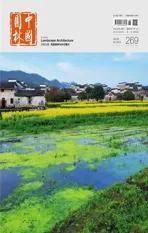刊首语
2018-01-26金荷仙
2018年2月4日,《中共中央国务院关于实施乡村振兴战略的意见》由新华社受权播发。按照产业兴旺、生态宜居、乡风文明、治理有效、生活富裕的总要求,对统筹推进农村经济建设、政治建设、文化建设、社会建设、生态文明建设和党的建设做出全面部署。
近年来,风景园林行业积极参与美丽乡村建设、乡村旅游、全域景区化等工作热潮,积极开展乡村风貌保护、乡村遗产保护与利用工作,取得了很好的成绩。然而,我们也需要反省一些行为和现象。我们曾被乡村旅游万能论包围,大笔一挥的 “旅游线路”,遍地开花的 “民宿开发”曾经充斥乡村;我们曾热衷于统一整治,漠视传统建筑和文化遗存;我们曾过度使用水泥等材料,导致古树窒息、水系枯竭、青石小巷湮没……在模式化、样板化的快速建设进程中,乡村风景园林审美传统被遗弃,乡村风貌遭到破坏。陶渊明《归园田居》云:“种豆南山下,草盛豆苗稀。晨兴理荒秽,戴月荷锄归。道狭草木长,夕露沾我衣。衣沾不足惜,但使愿无违。”传统乡村审美,今日何存?现代乡村人居美学标准还未形成,现代乡村可持续发展研究和重建工作任重而道远。
“方宅十余亩,草屋八九间。榆柳荫后檐,桃李罗堂前。暧暧远人村,依依墟里烟。狗吠深巷中,鸡鸣桑树颠。户庭无尘杂,虚室有余闲。”在另一首诗中,陶公以舒缓愉悦的笔墨描绘了一个庭院雅洁、花木清和、万物相谐的园林式乡村,在这个抚慰心灵的归隐之地,发出 “久在樊笼里,复得返自然”的由衷感叹。中国古代园林曾经是文人归隐山水、舒缓乡愁的寄托。如今,风景园林能否成为乡村发展的一剂清凉帖?能否缓解当前快速城市化进程带来的阵痛,舒缓我们愈加浓烈的乡愁?乡村作为寄托乡愁的最初和最后一片蓝海,我们需倍加珍惜。
乡村曾直接影响中国风景园林审美传统的形成和发展。“园林”一词,最早出现于西晋张翰的诗句:“暮春和气应,白日照园林。”这首诗的出现开启了我国的风景园林文明,比西方的田园诗早了1 000多年。2010年《世界遗产报告26:世界遗产文化景观保护与管理手册》 明确指出:“衡量景观文明有4项标准:具有特指景观的专有名词;文学与诗歌对景观的吟咏;绘画对景观的表现;造园的艺术。符合这4项的有两大文明:最早在公元3—4世纪信奉 ‘道’的中国以及后来的西欧(始于15世纪)。”
乡村振兴首要在于人心的回归。“后之视今,亦犹今之视昔”。晋人朴素的乡村田园审美观,体现了中国古人 “天人合一”的生态智慧。在乡村振兴浪潮中,风景园林必将为乡村发展带来新的着力点和增长极。“夫美不自美,因人而彰。兰亭也,不遭右军,则清湍修竹,芜没于空山矣”。风景园林师的自然审美、乡村审美意识应该在乡村工作中起到积极作用。在乡村这方广阔的天地,风景园林与乡村必能保持天人合一的传统,以风景园林事业推动乡村建设进一步雅化、活化,创作出有风度、有品质的新乡村人居美学。
乡村振兴对我国风景园林的发展尤其重要,当下正是我们再续“园林与乡村”前缘的重要历史时机。我们要以此为契机,复兴我国乡村审美,唤人心、归田园、振乡村,传承我国风景园林在世界风景园林史上独树一帜的 “天人合一”传统,同时注入现代文明可持续发展智慧,建设景观和谐、功能齐全的园林式乡村。
恰逢天时与地利、机遇与挑战、时代与传统共振之际,我们不可不至诚以待,勉力担当,再续文脉!
乡村振兴工作的开展,必将唤醒我们的敬畏自然之心,重启我们的乡村审美之眼,中国悠久的风景园林智慧和文明传统,也必将由此复兴!
On February 4, 2018, theOpinions of the Central Committee of the Communist Party of China on Implementing the Strategy for Revitalizing the Villagewas broadcasted by the Xinhua News Agency. In accordance with the general requirements of industrial prosperity,ecological livability, rural civilization, effective governance, and affluent life, we must make overall arrangements for the overall promotion of rural economic construction, political construction, cultural construction, social construction, ecological civilization construction,and party building.
In recent years, the landscape architecture industry has actively participated in the upsurge of beautiful rural construction, rural tourism, and global scenic spots. It has actively carried out work on the protection of rural landscapes and the protection and utilization of rural heritage, and has achieved many good results. However, we also need to reflect on some behaviors and phenomena. We were once surrounded by the rural tourism universal theory, and the "tourism routes" with a stroke of the pen, and the"homestay development" has once blossomed all over the country; we were keen to overall renovation and ignore the traditional buildings and cultural relics; we excessively used materials such as cement, which made old trees suffocated, the water system dry up, and the pebble and bluestone lanes disappear… In the rapid construction process of modelling, the aesthetic tradition of rural landscape was abandoned and the village style was destroyed. Tao Yuanming wrote inBack to Country Life: "Down the South Range beans I raise, weeds run riot but the shoots are weakly few. Weeding I start at sun rise,Hoe across my shoulder, moonlight sees me home. The trail is flanked with weeds and trees, wet are my clothes with evening dew. Little does the cold dew bother me, as long as I have my will." Traditional village aesthetics, where is it now? The standard of modern rural residential aesthetics has not been formed yet, and the study and reconstruction of modern rural sustainable development have a long way to go.
"My farm contains a dozen mu of ground, and my cottage has eight or nine rooms around. The elm and willow cover backside eaves, while peach and plum trees shade my yard with leaves. The distant village dimly looms somewhere, with smoke from chimneys drifting in the air. In silent country lanes a stray dog barks, and amid the mulberry trees cocks crow with larks. My house is free from worldly moil or gloom, while ease and quiet permeate my private room." In another poem, Tao Yuanming described a garden-like village with elegant courtyards, flowers and trees, and all harmonious things, in a soothing and pleasant brushstroke. In this soul-healing seclusion place, he expressed his heartfelt plaint that "when I escape from bitter strife with men, I live a free and easy life again." Ancient Chinese gardens used to be the sustenance of literati to retire back to landscape and relieve their homesickness. Today, can landscape architecture become a cool and refreshing stick for rural development? Can we ease the pain caused by the rapid urbanization process and relieve our increasingly strong homesickness? As the first and last place for our homesickness, we should cherish the countryside.
The countryside once directly affected the formation and development of the aesthetic tradition of China's landscape architecture. The term "garden" first appeared in Zhang Han's verse in the Western Jin Dynasty: "the late Spring blends with the environment, and the daylight shines the garden." The appearance of this poem opened the landscape civilization of China and was more than 1,000 years earlier than the Western pastoral poetry. In 2010World Heritage Report 26: World Heritage Cultural Landscape Protection and Management Manual, it was clearly stated: "There are four criteria for measuring landscape civilization:proper nouns specifically for landscapes; literature and poetry on landscapes; paintings on landscapes; gardening art. There are two major civilizations in line with these four criteria:China which first believed in the Tao in the 3rdto 4thcentury AD, and later Western Europe(since the 15thcentury)."
The rejuvenation of the countryside lies primarily in the return of people's feeling."The later generations seeing the present is just like how we view the past". The simple rural aesthetics of the Jin Dynasty reflected the ancient Chinese ecological intelligence of "human-nature integration". In the wave of rural revitalization, landscape architecture is bound to bring new acting point and growth pole to rural development. "Beauty is not known by itself, but by the appreciation of man. Just like Lanting Pavilion, if not written by Wang Xizhi, the clear rapids and slender bamboos would be deserted and hidden in the mountains." The landscape artists' natural aesthetic and rural aesthetic consciousness should play an active role in rural work. In the vast countryside, landscape architecture and rural areas will be able to maintain the tradition of integration of nature and human. The use of landscape architecture will further promote the development of village construction to be more graceful and lively, and will create new rural aesthetics with grace and quality.
The revitalization of the countryside is particularly important for the development of China's landscape architecture. Now is the important historical opportunity for us to renew the earlier connection between "garden and village". We must use this as an opportunity to rejuvenate our country's rural aesthetics, call back the people's feeling, return to the pastoral countryside, and invigorate the countryside. We should inherit the tradition of"human-nature integration" which is unique in the history of world landscape architecture,and at the same time inject the wisdom of sustainable development of modern civilization,to build the garden-style countryside with harmonious landscape and complete functions.
It is precisely at the time of day and location, opportunities and challenges, and the times and traditions are in resonance. We must be sincere, ready to act, and continue the cultural context!
The development of rural revitalization will inevitably awaken our respect for nature and rekindle our eyes on rural aesthetics. China's long-standing landscape wisdom and civilized tradition will surely be revived!
